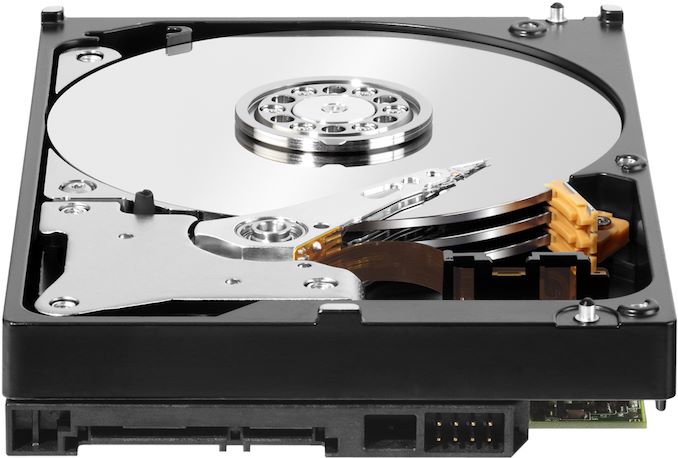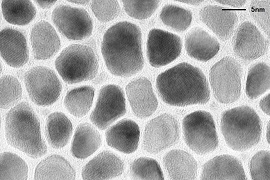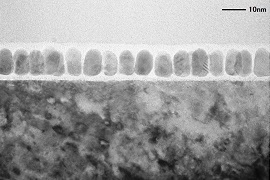The Road to 80 TB HDDs: Showa Denko Develops HAMR Platters for Hard Drives
by Anton Shilov on February 6, 2020 2:30 PM EST- Posted in
- Storage
- Seagate
- Toshiba
- Western Digital
- HAMR
- Showa Denko
- SDK
- HDD

Showa Denko K.K. (SDK) has unveiled the the company has finished the development of its next-generation heat assisted magnetic recording (HAMR) media for hard drives. The platters use all-new magnetic thin films with a very small crystal grain size in order to maximize their areal density, with the goal of eventually enabling 3.5-inch HDDs to be built with capacities of 70 TB to 80 TB.
SDK’s platters for HAMR HDDs use glass substrate and feature thin film magnetic layer made of an Fe-Pt alloy. To improve the magnetic coercivity of the media by several times over existing platters, Showa Denko used a new structure of magnetic layers and implemented new ways of controlling the temperature of the media during production.
UPDATE 2/21: As it turns out, Showa Denko will use glass substrates for platters designed for HAMD hard drives because of their superior heat resistance.
Driving these developments, it's critical to maximize the magnetic coercivity of next generation HDD platters because the crystal grains used to record data are getting extremely small. This has made them very easy to magnetize, but it has also reduced the strength of the individual magnetic signatures, which creates an unwanted magnetic inter-track interference (ITI) effect that makes it harder for HDD heads to read the data. Platters with high magnetic coercivity require energy assistance during writing and this is what energy assisted magnetic recording technologies (HAMR, MAMR, ePMR, etc.) are all about. Meanwhile, the platters must survive extreme temperatures they are subjected to during heat-assisted recording. According to Showa Denko, its new HAMR platters offer the industry’s highest read-write characteristics and durability.
Transmission Electron Microscopy Images of HAMR Media
Plain View Cross Section
SDK is not disclosing the recording density of its new platters nor are they making specific promises about when it intends to start mass production of next-generation disks. Meanwhile, the company notes that today’s leading-edge conventional magnetic recording (CMR) platters feature recording density of about 1.14 Tb/in2 and it is widely believed that this is not going to grow significantly without using energy assisted recording methods. By contrast, Showa Denko believes, HAMR-based media will achieve areal density of 5-6 Tb/in2 in the future, which will increase capacity of hard drives by several times, all the way to 70 TB – 80 TB per 3.5-inch drive without increasing the number of platters. For comparison's sake, today’s 16 TB CMR (PMR+TDMR) HDDs use nine disks, so increasing their density by ~5.2X would enable drives featuring capacities higher than 80 TB.
Showa Denko is the world’s largest independent maker of platters for hard drives, selling media to all of the HDD producers. That said, the large manufacturers — Seagate and Western Digital — also produce media themselves and tend to use their own leading-edge platters to cut costs and maximize product margins. So it will be interesting to see which of three remaining hard drive makers will be the first to use HAMR platters from Showa Denko.
Seagate will be the first company to adopt HAMR for commercial 20 TB drives in late 2020, but since Showa Denko now only plans to ‘make preparations for full-scale supply of the new HD media’, it is likely that the first HAMR drives will use Seagate’s own platters. Toshiba is expected to use Showa Denko’s 2 TB MAMR platters for its 18 TB HDDs that are projected to arrive later this year, but in the longer terms it will switch to HAMR (we have no idea when). By contrast, Western Digital uses its so-called energy-assisted PMR (ePMR) technology for its 18 TB and 20 TB HDDs due this year and will gradually move to MAMR and HAMR in the years to come.
Related Reading:
- Toshiba's HDD Tech Roadmap: A Mix of SMR, MAMR, TDMR, and HAMR
- 18 TB HDDs: Toshiba Collaborates with Showa Denko for MAMR HDDs
- HOYA Starts to Build Next-Gen HDD Glass Substrate Production Facility
- Seagate: 18 TB HDD Due in First Half 2020, 20 TB Drive to Ship in Late 2020
- Western Digital Roadmap Updates: Energy Assisted Recording, Multi-Stage Actuators, Zoned Storage
Source: Showa Denko












75 Comments
View All Comments
Brane2 - Friday, February 7, 2020 - link
Both. Youcan easily interlieve sectors so that come on sequential heads.One doesn't even have to do it in drive. Computer driver can take care of that.
And do many other things.
I suppose Linux Filesystem structure will be updated and changed to be able to take advantage of those new mechanisms...
bcronce - Friday, February 7, 2020 - link
OpenZFS recently got DRAID http://open-zfs.org/wiki/DRAID_Rebuild_PerformanceNot sure which platforms currently have it yet or how mature it is.
Brane2 - Friday, February 7, 2020 - link
When they get to 40-ish TB per drive, with multihead RAID-like access and two heads per platter at low per-showel prices like we have now for 2TB, they will present GREAT archival option that could trigger avalanche of new orders.AND - interchangeable electronics. So that if electronics on one drive dies, it can easily be interchanged with another and data rescued. It was possible long ago and I don't see a reason why it shouldn't be possible again.
AND, it would be nice to have separate external pin that would enable one to turn drive totally off.
So you could have say 100 drives on the same cold-storage machine, consuming no power on idle.
With a little help from cheap microcontroller on the side...
No one needs the porn so bad that access time difference SSD/HDD would make meaningful difference ;o)
For long-term data archival OTOH, HDDs seem bo unbeatable for mere mortals.
GreenReaper - Friday, February 7, 2020 - link
As someone who runs such a site, it depends. Sure, the full files we have on RAID5. But reduced-sized previews and thumbnails go on RAID10 and SSD if available - for IOPS if not for access times. (Although obviously the two can be almost directly related when it comes to HDDs.)sorten - Friday, February 7, 2020 - link
I assume that at some point you'll fix the broken purch js scripts.A little difficult for me to get excited about cold storage drives. LOL @ people talking about using these in a RAID.
Valantar - Friday, February 7, 2020 - link
Let's see ... a 5x increase in density might lead to a near-linear increase in read speeds, but I have a feeling write speeds won't reach those levels - especially if we're talking SMR on top of this stuff. So let's say one of these 80TB drives manages to do 500MB/s reads and 300MB/s writes. That would make them very fast for an HDD, but ...300*60*60*24=25 920 000 megabytes of writes per day in a perfectly sequential workload (which never happens). That's more than three full days to fill the drive.
500*60*60*24=43 200 000 megabytes of reads per day. So nearly two full days to read out the entire drive - and that's if you ignore the file system entirely and just clone the raw data track by track sequentially. _Any_ seek time added between files would dramatically increase this time.
In short, storage like this is wildly impractical outside of deployments with absolutely massive redundancy, and even there it has serious issues.
eastcoast_pete - Friday, February 7, 2020 - link
Interesting article - but, when will we see these in action?And, to those who ask who needs such enormous drives? Try backing up 4K and soon 8K footage, and you'll see soon that there is no such thing as too much storage space. And yes, editing is much better done from large NVMe SSDs, but you still want to have the raw backups on spinning rust.
sheh - Friday, February 7, 2020 - link
Modern 3.5" HDDs average 150-190MB/sec.For years now read/write speed has been growing slower than data density. If that wasn't the case, reading a whole drive wouldn't have grown from a few minutes in the past to many hours today.
The problem is that speed grows only from increases in linear density (inside a single track), while most of the density growth is from an increase in the number of tracks (tracks per inch).
I think write speed should be the same as read.
sheh - Friday, February 7, 2020 - link
The above is a reply to valinor89.(AnandTech, reply threading is broken when JavaScript is disabled. It's been like that for... 10 years now?)
ksec - Saturday, February 8, 2020 - link
Most may not have a need for 70 - 80TB Desktop HDD, but I would surely want a 8- 20 TB Size HDD in Notebook 2.5" format.